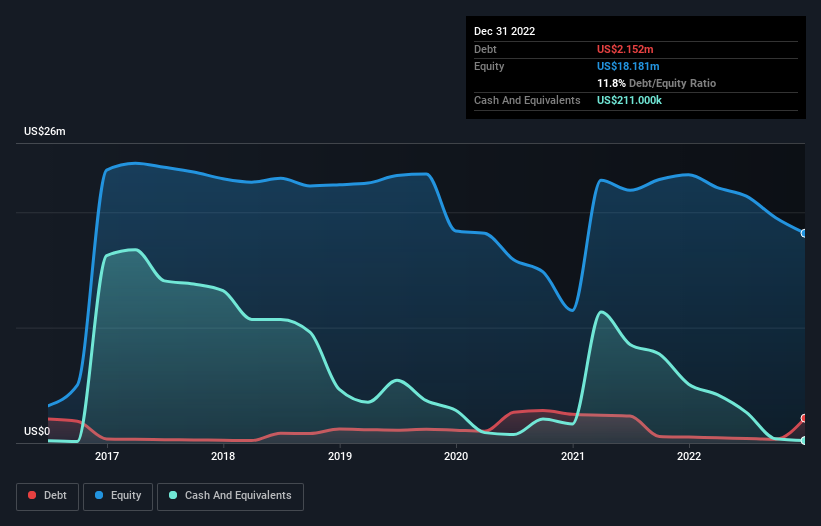
Warren Buffett famously said, 'Volatility is far from synonymous with risk.' So it seems the smart money knows that debt - which is usually involved in bankruptcies - is a very important factor, when you assess how risky a company is. As with many other companies Polar Power, Inc. (NASDAQ:POLA) makes use of debt. But is this debt a concern to shareholders?
Why Does Debt Bring Risk?
Debt is a tool to help businesses grow, but if a business is incapable of paying off its lenders, then it exists at their mercy. Ultimately, if the company can't fulfill its legal obligations to repay debt, shareholders could walk away with nothing. While that is not too common, we often do see indebted companies permanently diluting shareholders because lenders force them to raise capital at a distressed price. Of course, plenty of companies use debt to fund growth, without any negative consequences. The first step when considering a company's debt levels is to consider its cash and debt together.
See our latest analysis for Polar Power
How Much Debt Does Polar Power Carry?
As you can see below, at the end of December 2022, Polar Power had US$2.15m of debt, up from US$510.0k a year ago. Click the image for more detail. However, because it has a cash reserve of US$211.0k, its net debt is less, at about US$1.94m.

A Look At Polar Power's Liabilities
According to the last reported balance sheet, Polar Power had liabilities of US$5.95m due within 12 months, and liabilities of US$57.0k due beyond 12 months. On the other hand, it had cash of US$211.0k and US$5.02m worth of receivables due within a year. So its liabilities total US$779.0k more than the combination of its cash and short-term receivables.
Since publicly traded Polar Power shares are worth a total of US$16.6m, it seems unlikely that this level of liabilities would be a major threat. Having said that, it's clear that we should continue to monitor its balance sheet, lest it change for the worse. There's no doubt that we learn most about debt from the balance sheet. But it is Polar Power's earnings that will influence how the balance sheet holds up in the future. So when considering debt, it's definitely worth looking at the earnings trend. Click here for an interactive snapshot.
In the last year Polar Power had a loss before interest and tax, and actually shrunk its revenue by 5.0%, to US$16m. We would much prefer see growth.
Caveat Emptor
Importantly, Polar Power had an earnings before interest and tax (EBIT) loss over the last year. Its EBIT loss was a whopping US$5.5m. When we look at that and recall the liabilities on its balance sheet, relative to cash, it seems unwise to us for the company to have any debt. So we think its balance sheet is a little strained, though not beyond repair. Another cause for caution is that is bled US$6.5m in negative free cash flow over the last twelve months. So in short it's a really risky stock. There's no doubt that we learn most about debt from the balance sheet. However, not all investment risk resides within the balance sheet - far from it. For instance, we've identified 3 warning signs for Polar Power (2 are a bit concerning) you should be aware of.
If you're interested in investing in businesses that can grow profits without the burden of debt, then check out this free list of growing businesses that have net cash on the balance sheet.
New: Manage All Your Stock Portfolios in One Place
We've created the ultimate portfolio companion for stock investors, and it's free.
• Connect an unlimited number of Portfolios and see your total in one currency
• Be alerted to new Warning Signs or Risks via email or mobile
• Track the Fair Value of your stocks
Have feedback on this article? Concerned about the content? Get in touch with us directly. Alternatively, email editorial-team (at) simplywallst.com.
This article by Simply Wall St is general in nature. We provide commentary based on historical data and analyst forecasts only using an unbiased methodology and our articles are not intended to be financial advice. It does not constitute a recommendation to buy or sell any stock, and does not take account of your objectives, or your financial situation. We aim to bring you long-term focused analysis driven by fundamental data. Note that our analysis may not factor in the latest price-sensitive company announcements or qualitative material. Simply Wall St has no position in any stocks mentioned.
About NasdaqCM:POLA
Polar Power
Designs, manufactures, and sells direct current (DC) power generators, renewable energy, and cooling systems in the United States and internationally.
Mediocre balance sheet low.
Market Insights
Community Narratives


